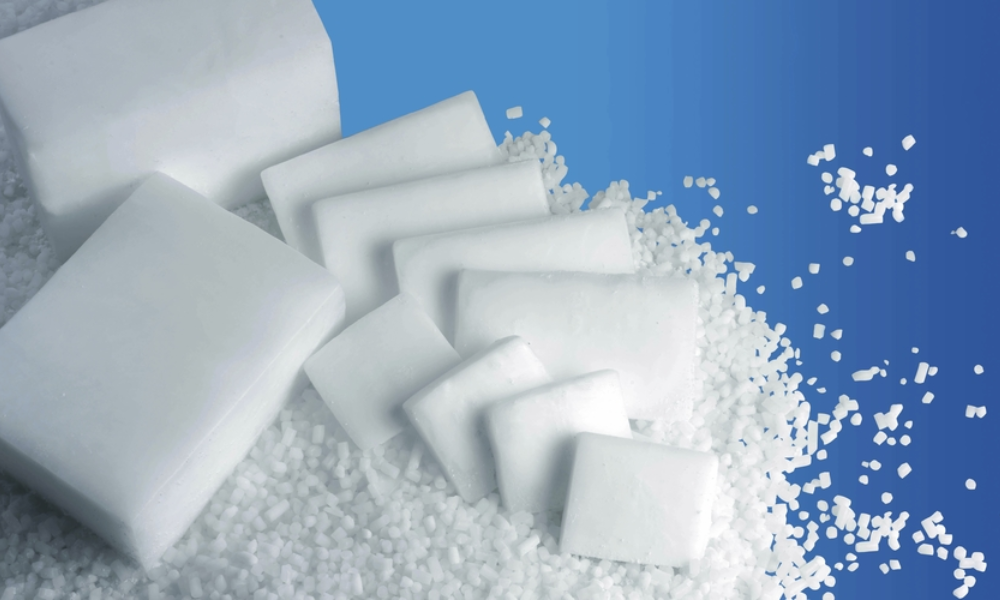Whether you are storing your dry ice at home or looking to ensure the quality and freshness of your ice, this article will be useful to you. Dry ice works well for cooling liquids and creating interesting effects. When dry ice isn’t being used, it’s crucial to keep it appropriately. It will last longer and eliminate any safety risks if you store your dry ice properly.
This article will teach you how to store dry ice safely and what to look for when storing dry ice, safety advice for dry ice, and what to do with dry ice. Is it possible to store it at room temperature? How long does it take for the ice to evaporate at room temperature? What happens if dry ice is left out on the counter, or what is the shelf life of dry ice? So let’s start!

What is Dry Ice?
Dry ice is carbon dioxide that has been frozen (CO2). In dry ice production, pure CO2 gas must first be compressed and chilled to transform into a liquid. Once the pressure has been released, the liquefied CO2 is fed into a dry ice production machine and compacted into blocks or pellets.
How to Store Dry Ice Safely?
Dry ice can be very helpful when a freezer is unavailable, yet extremely low temperatures are needed. With dry ice, it’s possible to acquire too much or too early and need storage occasionally.
Dry ice should be wrapped in a towel and kept inside an insulated container with a loose cover for safe storage. After that, place the container in a well-ventilated area. Here are some of the procedures to take to store dry ice:
Step 1. Protection: Always put on safety gear before working with dry ice. You only want insulated gloves for basic container transfers. However, it would help if you shielded your arms, face, and eyes while breaking the dry ice.
Step 2. Wrap a towel: Dry ice will stay longer if wrapped in a towel and placed inside an insulated container. Like regular ice blocks, dry ice preserves its consistency longer when coated in a towel or other piece of lace.
Step 3. Sealed container: Dry ice should be placed in an insulated container, such as an ice chest or a cooler, after being wrapped in a towel. The ideal dry ice storage container has closed-cell extruded polystyrene foam (XPS), also known as Styrofoam, on its walls.
Step 4. Folded Paper: You might occasionally have a container with more room than you require. Place the dry ice wrapped in a towel and then stuff all the space with crumpled paper. Consequently, the crumpled paper provides greater insulation by reducing the container’s air.
Step 5. Loose Lid: Use a loose lid to secure the top. This will let gaseous carbon dioxide that has been sublimated escape from the container. Remember that an airtight container can blow up because it cannot handle the pressure changes by sublimation.
Step 6: A Ventilated, Cold Environment: Place the insulated container in a cold, well-ventilated room once you’ve completed Steps 1 through 5. Doing this may make sure that the dry ice experiences very little sublimation. To prevent unplanned incidents, keep a close check on your storage area. Last but not least, keep dry ice out of children’s reach, as is advised on the box of most harmful items.
Things to Keep in Mind While Storing Dry Ice
Before acquiring and handling dry ice, consider the following useful items, as it might occasionally cause a small hiccup. Dry ice sublimation is unavoidable but can be slowed down. A few days before you use dry ice is the ideal time to buy it.
Prevention: When handled with bare hands, cold, dry ice can cause skin burns. The solution should be insulated gloves, like leather gloves or mittens. Wearing long sleeves to cover your arms can help increase protection further.
Safety: As usual, safer is preferred, so try to handle dry ice as little as necessary. If you must break it, cover it with a cloth and put on safety goggles to protect your hands, arms, eyes, and face. Handling dry ice in small spaces can also cause asphyxiation because it is essentially carbon dioxide gas.
Compared to air, carbon dioxide is heavier. It automatically goes to lower locations and replaces oxygenated air during sublimation. Avoid crouching or remaining low to handle dry ice if you accidently leave it in a confined location.
A Useful Container: Never keep dry ice in an entirely airtight container. Carbon dioxide is transformed from a solid to a gas during sublimation, which then expands to the place of oxygenated air. Excess carbon dioxide gas within the sealed container can cause it to expand or explode without ventilation and movement space. Use a sturdy cooler produced of Styrofoam with a loose lid instead.
Storage or Condition: Dry ice should always be kept in a frigid location with good ventilation. Dry ice sublimates less quickly when stored in a cold environment. And all the carbon dioxide gas that is building up may be replaced with enough ventilation and airflow.
Before buying dry ice, get some safety equipment ready. Dry ice should never be placed on top of ceramic surfaces or countertops. These surfaces may crack or break due to the extremely low temperature.
It is suggested to sequester carbon dioxide (CO2) from coal-fired and oxygen-blown gasifier combined cycle power generation plants (GuD) and to store it in the form of CO2-dry ice in sizable, thermally insulated repositories in their vicinity to delay the emission of CO2 into the atmosphere to significantly reduce the atmospheric CO2-peak, which is responsible for the greenhouse effect.
Reference: The terrestrial storage of CO2-dry ice.
Safety Advice for Dry Ice
Due to its extremely cold surface temperature, dry ice can cause skin injury and frostbite. To assist in preventing contact injuries, take these actions. These are some recommendations that can reduce risks when handling dry ice.
- Never use bare hands to contact dry ice. Exam gloves made of nitrile won’t adequately protect you. Gloves with insulation are suggested.
- Cryogenic gloves are made specifically for handling extremely cold objects.
- Use proper eye protection, like safety glasses or a face shield.
- Avoid keeping dry ice in poorly ventilated enclosed spaces, such as basements or walk-in freezers.
- Because CO2 is about 1.5 times heavier than air, it can replace oxygen in confined or compact places.
- If dry ice sublimes quickly, even a very little piece of it can release a significant amount of CO2 gas.
- High amounts of CO2 are harmful and can swiftly result in someone losing consciousness and their ability to breathe.
- Dry ice should be kept in airtight containers. Only store dry ice in containers with a gas vent. When dry ice melts inside a tightly closed container, the CO2 gas inside will pressurize the container, which may eventually lead to a rupture or explosion.
Is it Possible to Keep Dry Ice at Room Temperature?
To prevent sublimation (solid carbon dioxide sublimes at lower temperatures into enormous amounts of CO2 gas and is hazardous to handle), dry ice is held at ambient temperature and one pressure atmosphere. At the earth’s atmospheric pressure, dry ice sublimates at a temperature of 78.5 C (109.3°F or 194.7 K).
How Long does Dry Ice Take to Evaporate at Room Temperature?
At normal temperatures, dry ice generally sublimates at a rate of 5 to 10 pounds per hour. It takes 3-5 hours to drain if you leave it outside. When placed in a liquid, dry ice sublimates significantly more quickly than in the open. When submerged in water, a 5-pound block will sublimate in 15 minutes.
What Occurs if Dry Ice is Left Out on the Counter?
On a tile or laminate surface, avoid using dry ice. Dry ice should be kept from evaporating in an enclosed space. It can quickly suffocate a person by releasing a buildup of carbon dioxide into the air. Use a sturdy surface in its put; the great options are a wooden cutting board or a piece of plywood.
Can Dry Ice Cause Carbon Dioxide Poisoning?
The transformation of dry ice from a solid to a gas can produce significant amounts of carbon dioxide. Though it only makes up a very small portion of the air we breathe (less than a tenth of one percent), carbon dioxide is present and can be hazardous in large doses. Dry ice in enclosed, inadequately ventilated environments has the potential to induce carbon dioxide poisoning.
Signs and Symptoms of Carbon Dioxide Poisoning:
A carbon dioxide exposure early sign is rapid breathing. In addition to a headache, dizziness, and sleepiness, carbon dioxide poisoning also causes symptoms comparable to oxygen deprivation.
How Long will Dry Ice Last?
As you may know, dry ice (frozen carbon dioxide, the same gas we breathe) performs a great job of keeping food cool and even frozen. If it is packed properly, it will endure a shockingly long period. The size of the cube and how it is stored significantly impact how long dry ice lasts.
Outside lasts 3 to 5 hours, and liquid: 15 to 45 minutes. If 20 pounds of dry ice is left outside, at least 10 pounds will be lost in 24 hours. The length of sublimation depends on the amount of dry ice you have and the storage methods you use. When dry, ice remains solid also depends largely on temperature and airflow.
Conclusion
The main goal of storage is to stop the transformation of dry ice into carbon dioxide gas. Dry ice can be safely stored after you understand the fundamentals, which isn’t too difficult. Protective clothing, insulated containers with a loose cover, crumpled paper for further insulation, and a cold, well-ventilated storage area should all be used.
The simplest way to handle dry ice is to put it in a container. A corrugated box is ideal, and it should be sealed with plastic carton sealing tape. When you have packed your dry ice in a well-insulated container, you should store it away from low areas where carbon dioxide will build up.
